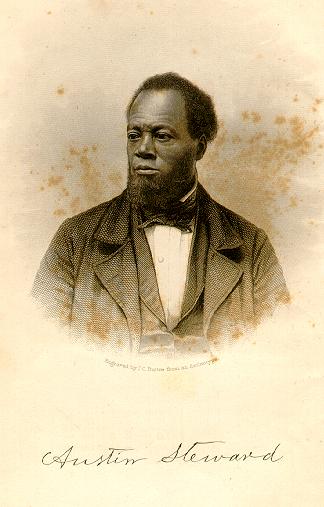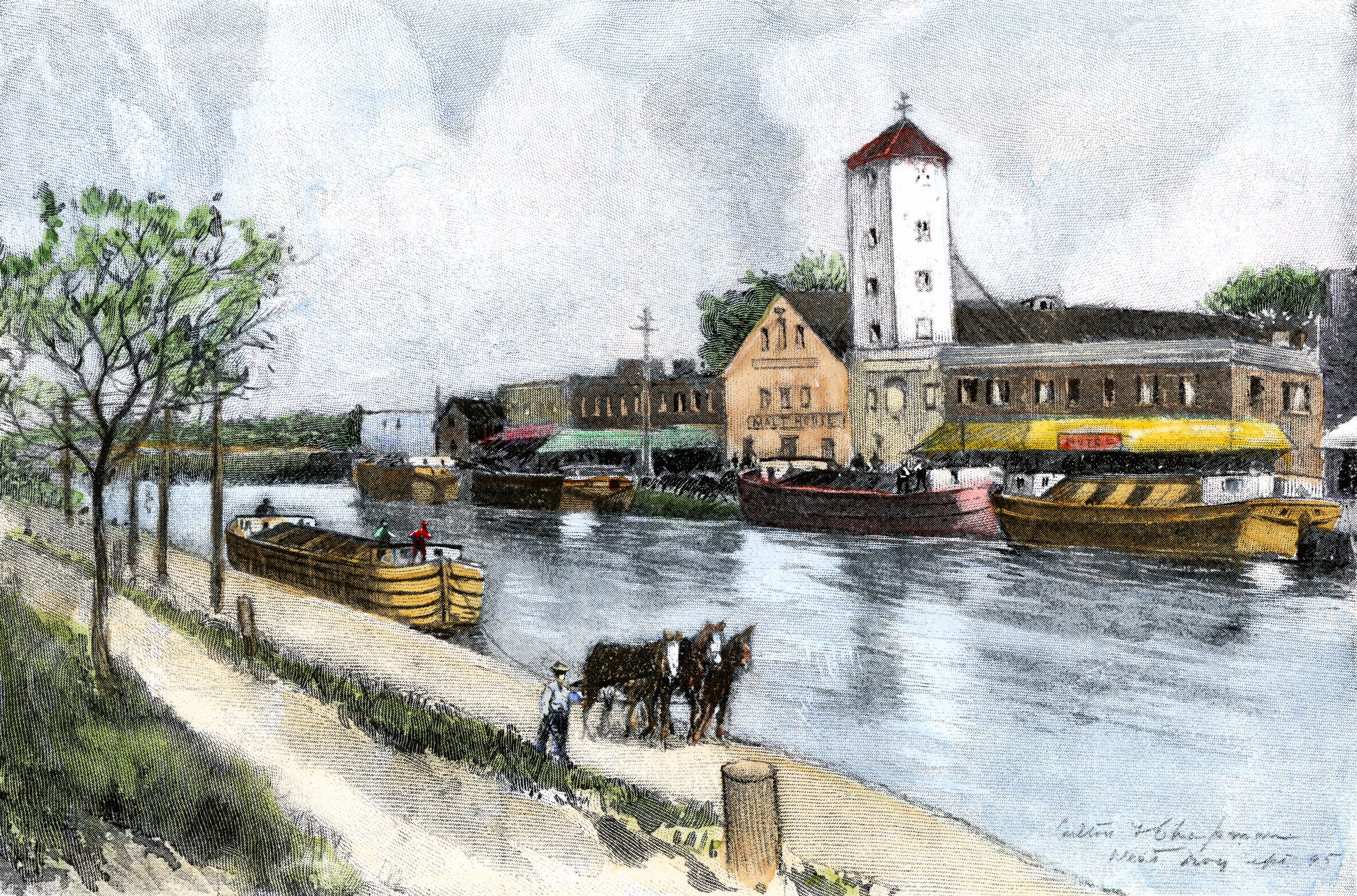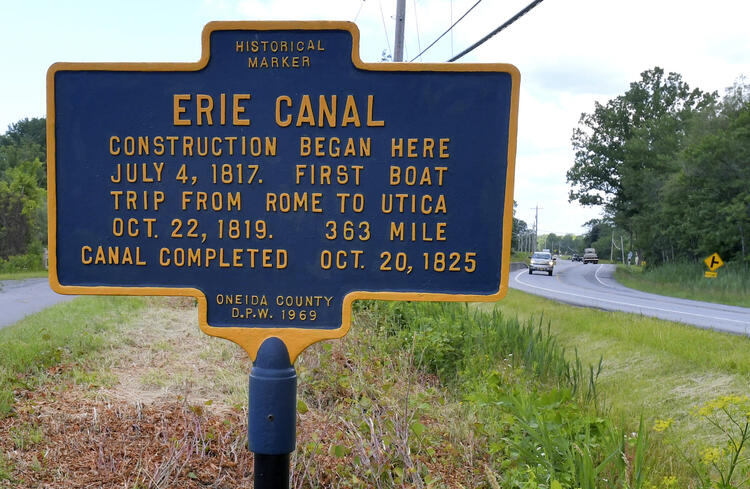Austin Steward was born into slavery in 1793 in Virginia, where he worked as an errand boy on the plantation of a cruel master. Whippings were common, and meager food and clothing were all he was given for his excruciating labor. Yet he was a person of remarkable energy and spirit. He managed to teach himself to read in secret, an act for which he was beaten.
Steward eventually escaped after his master sold the plantation and moved his household and slaves to New York state. Steward gained his final freedom with legal help from the New York Manumission Society, an abolitionist group, and made his way to Rochester. In short order he opened a butcher shop and then a general store on Main Street, creating a thriving business. He was just 24. He saw his success as a reason to help others and found time to teach Sunday School, host black reform meetings and distribute abolitionist newspapers. Freedom was not simply the release from a former state of being. For Steward it was a call to action and responsibility.
Ten years later Steward had become such a key figure for the black community of Rochester that he was asked to give a speech during celebrations marking the end of slavery in New York, on July 5, 1827. His Emancipation Day oration began with optimistic words: “The age in which we live is characterized in no ordinary degree, by a certain boldness and rapidity in the march of intellectual and political improvements.”
The Erie Canal radically transformed the young United States, reconfiguring national religious and social dynamics by connecting the continental interior with the eastern seaboard.
The Erie Canal had recently been completed—Steward’s shop was but a couple of blocks from its waters—and his speech teemed with confidence about new technologies and how technology flowed together with social progress toward the “state of earthly perfection.” Begun in 1817, by its completion the canal connected Rochester with the Great Lakes in the west and Albany and New York City to the east. It was a technological marvel that radically transformed the young United States, producing large amounts of wealth in New York and reconfiguring national religious and social dynamics by connecting the continental interior with the eastern seaboard.
During this time, Steward gained prominence by offering goods for Rochester as the town fed off the canal; the town’s population swelled by 500 percent between 1820 and 1830. For business owners like Steward, economic markets created in canal towns provided independence. Farms, industry and consumer stores could be locally owned and operated while remaining connected to the global market.
The Waters of Opportunity
As new life flourished along the canalway, New York State took many of the antislavery currents flowing across the country and brought them rapidly to prominence (though it must be noted that emancipation came much later in New York than it did in other Northeastern states). The canal generated an economy that did not rely directly on slave labor, and it made New York’s economy the most dynamic of the antebellum era. Meanwhile, the canal’s transportation network created branches for the underground railroad—churches all along the canalway provided stations—and soon began carrying abolitionist newspapers and pamphlets for distribution across the nation.
Religious arguments over slavery were anything but settled at the time. Congregations split over the issue, while new ones were formed, including many African-American denominations, as theological interests intersected with economic interests and political movements. “Religion had given birth to abolitionism in the Burned-over District,” notes historian Milton Sernett, referring to central and western New York, in his study of African-American freedom movements, North Star Country, “but now abolitionism pitted Christian against Christian.”
Presbyterian, Methodist and Baptist denominations all had major theological debates about slavery, sometimes leading to schisms over abolition, usually separating along north-south lines. The Methodist Episcopal Church, the largest denomination and probably the most influential institution apart from the federal government itself in ante-bellum America, split in 1844 over abolition. Its northern denominations were increasingly opposed to slavery, leading to the formation of the Methodist Episcopal Church, South, in which clergy were not allowed to own slaves, but they took no explicit stance against slavery for the general population.
People like Frederick Douglass, Sojourner Truth and Harriet Tubman all connected with one another across the Erie Canal corridor.
Meanwhile, a great many of those working for African-American freedom were devout Christians. People like Steward, Frederick Douglass, Sojourner Truth, Jermain Loguen, Samuel Ward and Harriet Tubman all connected with one another across the Erie Canal corridor and called on fellow Christians to rise up against the sinful injustice of slavery. Yet theology does not work well in abstraction, separated from geographical and technological realities.
Religious historians have long noted the impact of Charles Finney’s revivalist theology as part of the Second Great Awakening that burned along the canalway. Finney helped overturn then-current Calvinist theologies rooted heavily in a divinely determined world that left little room for individual freedom of choice. For the puritanical Calvinists who dominated the beginnings of the nation, improvement and ultimately perfection were in the hands of God. This is what Finney intellectually turned upside down.
Yet ideas like free will and earthly, human perfectibility that Finney espoused would have found no purchase without the waters of the canal, along which he lived and worked for many years. For there, directly in front of people like Steward, was the aquatic thread that linked them to a globally based economic prosperity, a democratic governance made possible through the spread of news and information, and an enthusiastic religious life whose currents traveled far and wide. Mormonism, Spiritualism, Adventism and several other seemingly utopian societies all emerged along the Erie Canal soon after its completion. Steward and others living in the canalway did not just hear revivalist and utopian society leaders speak about perfection; they saw perfection’s potential flowing through the streets.
Austin Steward’s Freedom
In this environment, Steward became a Rochester subscription agent for Freedom’s Journal, the first ever black-owned and operated newspaper. It was started in March 1827 in New York City and distributed across upstate New York cities over the canal. The newspaper was founded by the Rev. Peter Williams Jr. and edited by John Russwurm and Rev. Samuel Cornish to counter the racism found across much of the mainstream press and focus on the unique African-American identity. From the beginning, Cornish and Russwurm stressed the centrality of education for black people in society, and the paper’s work was “to urge upon our brethren the necessity and expediency of training their children, while young, to habits of industry, and thus forming them for becoming useful members of society.” Even though Freedom’s Journal was published for only two and a half years, it helped open the door for many African-American and abolitionist newspapers to come, including William Lloyd Garrison’s The Liberator (1831–65), and eventually Douglass’s The North Star, begun in 1847 in Rochester.

Steward believed in education as a way to empower black youth, and Christian groups at the time, black and white, worked for the emancipation and education of African-Americans. Along the canalway in the first half of the 19th century, new educational institutes like the Oneida Institute, Whitesboro Seminary and Clinton Seminary emerged to provide education to whites and blacks alike. (Even so, formal education for blacks, outside home and church, was almost nonexistent until late in the 19th century.) It was seldom enough to abolish slavery; it was essential to create a socioeconomic structure that provided free blacks with a life of meaning, work and purpose.
As Steward became more involved in the socio-political arena, he hosted reform meetings around the region, and he was made the vice president of the first national “Colored Convention” in Philadelphia in September 1830. The Rev. Richard Allen, founder of the African Methodist Episcopal (A.M.E.) church denomination, the first independent black church in the nation, was president. Conversations at the convention centered around labor rights and black education, while one of the key tasks of the conveners was to organize The American Society of Free Persons of Color in Canada.
Ideas like free will and earthly, human perfectibility would have found no purchase without the waters of the canal.
The following year Steward took his money to Canada to help the fledgling society—later renamed the Wilberforce Colony, after the British philanthropist and abolitionist—to create a free place for African-Americans fleeing oppressive situations in the United States. The colony was a direct response to riots that occurred in 1826, and again with more virulence in 1829, in Cincinnati. Here whites, many of whom had moved west when the Erie Canal was completed, rose up against the waves of blacks who arrived from the south and competed for menial labor jobs.
Having seen the success of the Erie Canal and its impact on New York state, Ohio had undertaken its own canal building projects in 1825, with the Miami & Erie Canal linking Cincinnati with Lake Erie. Unlike Western New York, however, the tensions between groups of people, especially those with “lower” status, including those digging canals, were more pronounced in Cincinnati as they fought over resources, leading to white attacks against blacks. The violence continued for months, and by the end of summer 1829 over 1,000 African-Americans fled the city. Many moved north to Canada, and a number of them ended up in the Wilberforce Colony established for free blacks.
Steward uprooted his family and his money from Rochester in 1831, took a canal boat to Buffalo, another boat across Lake Ontario and finally rode a wagon to the colony. After a two-day journey north of Toronto, the land was “one unbroken wilderness,” as he recalled it, and Steward found the people there starving and destitute. For those who had already come, it was nonetheless a better alternative than staying in Cincinnati. Steward brought his skills and money, and was quickly named president of the Wilberforce Colony. Collectively they established schools and crops, two churches and a temperance society, and were gaining in number for some years, reaching 166 persons by 1835.
Yet fundraising proved difficult, leaving the Wilberforce Colony, and hence Steward, nearly broke, prompting Steward to sheepishly return to Rochester by 1837. Steward later looked back on the time in Canada with jaded eyes. His autobiography, Twenty-Two Years a Slave and Forty Years a Freeman, tells a series of depressing, occasionally gruesome, stories about his time there.
Two Freedoms
There is a kind of freedom that can be expressed as freedom from: freedom from enslavement, freedom from economic centralization putting money in the hands of kings, and freedom from church authorities tightly regulating salvation and access to the sacred. As early Americans followed the canal westward, farther from the institutional churches and governmental structures of old England and New England alike, freedom from the past became a central preoccupation.
On the other side is freedom to: freedom to work and create one’s own business; freedom to worship and assemble and perhaps even form one’s own religious movement; and freedom to enable others to escape the bonds of slavery and start a new life. Such positive freedom entails effort, as Steward’s life suggests: distributing newspapers, establishing utopian societies and schools, delivering speeches and community organizing.

These freedoms are two sides of the same coin, a coin that has become part of the religious currency of the United States. And it was in the Erie Canalway where the coin was gradually flipped, where freedom from yielded to freedom to, awakening the American dream as not merely God-given but as something a person must work toward. Steward’s life pivoted around both sides, freedom from slavery allowed him to have freedom to work for justice.
In a land where a former slave like Steward could become a successful business owner and Sunday School teacher on Main Street in a booming canal city, the perfectible state of humanity seemed to be within range. With the arrival of revivalist theology, abolitionist movements and canal system technologies, the ground was dug for a new way of experiencing the social order and working toward a “state of earthly perfection.”
Austin Steward’s narrative is mostly a success story about the after-effects of the Erie Canal and the socio-economic and religious freedoms it engendered. After he returned impoverished from Canada, he was helped by former social and business contacts. He built a new business along the canal in Rochester and once again became a prominent leader for antislavery, black suffrage and temperance causes. He would go on to teach school, preside over New York State black conventions and became a subscription agent for the National Anti-Slavery Standard. Following the success of A Narrative of the Life of Frederick Douglass, An American Slave (1845) and Solomon Northrup’s Twelve Years a Slave (1853), Steward published his autobiography in 1857, telling of a life flowing alongside broader social movements of his day. He died of typhoid in 1869, four years after the end of the Civil War.











How interesting that technology brought with it a religious group that was both intense yet open to diversity. Jobs, human dignity, and close communities seem to have won the day back then. Are these the answer today?
My physics teacher in my senior year at St. James Catholic High School told us students that technology was neutral. It was the way in which technology was used that made it either moral or immoral. From the article, I think it's clear that the spread of new ideas brought by the new technology represented by the Erie Canal ( the spread of abolitionism, the spread of new theology, that is, that people are not predestined for heaven or hell as John Calvin taught but that we have free will whether or not to do God's will, and the spread of employment and the establishment of new communities) were all good uses of technology.
However, as my Marianist brother physics teacher pointed out, technology can be used for either good or ill. For instance, medicine has made tremendous strides, both in my lifetime (I'm now 55), and even in the last century. (Needless to say, when we look at the medical practices of past centuries, we can really appreciate medical progress over the centuries). For instance, I believe that. in the early twentieth century, that insulin had not been developed. People who had diabetes had to deal with the disease as best as they could, without any significant useful medication. Undoubtedly, many people with the illness suffered the numerous physical side effects and even died early because physicians had no legitimate treatment. I happen to have type-two diabetes, and am fortunate that I can take insulin unlike people of an earlier era and not have the same risk of severe complications or early death. I also am grateful that I was diagnosed as an adult rather than having had the disorder as a young child. Another excellent advance in medicine wad the discovery of penicillin. Prior to that momentous event, people who had infections of whatever kind, minor or serious, again had to manage their illness as best as they could, with doctors not be able to treat patients with antibiotics. However, I believe that technology used in some practices thar involve medical procedures or drugs can be and in some cases is used for immoral purposes. When I was a youngster, amniocentisis had not been developed. This prenatal test can be used in one of four ways, three of of which in my opinion are moral. One way is for finding out the sex of the unborn baby, which I think is fine. Another is to reassure the pregnant woman that her unborn baby doesn't have a disability. A third use is to prepare parents emotionally for the birth of a disabled child and give them the opportunity to seek assistance. I might point out that I'm a retired Special Education teacher who worked with disabled people in various capacities for about 25 years. As a teacher, I educated children who had severe brain damage, or who were physically disabled or had behavior disorders. Teaching was often challenging but enjoyable. I now live in a nursing home/rehabilitation center and many of my friends or other residents are very elderly and have serious health issues or disabilities. However, prenatal testing can and often is used to determine if the unborn baby has a disability. In many cases the fetus (which means "young one" in latin) is killed if he or she has a disabling condition. I believe such a use of prenatal technology is immoral. I am not blessed to be a father. However, for many years I enjoyed helping my sister and brother with their 4 children by sitting with them, whom I dearly loved. Also, without being immodest, I believe my six years teaching special needs children helped convince me that their lives are worthwhile, and shouldn't be ended by the violence of abortion prior to birth. Another matter is the use of drugs. Drugs can of course be used in many ways, and sometimes even legal drugs can be abused and cause serious health problems or even death. However, if medication drugs are used properly when under the care of a physician, such drugs are both worthwhile and eminently moral.
However, at times certain drugs are used to give lethal injections to prisoners convicted of murder or another serious crime. This is undoubtedly unpopular with many Americans, but as I strongly oppose capital punishment, I believe such a use of such drugs for executions is immoral.